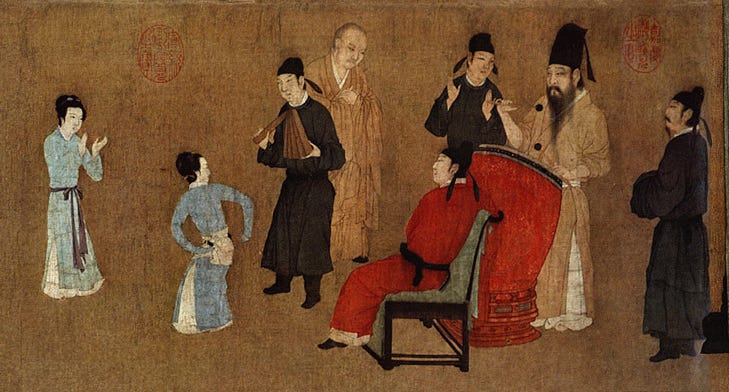A painting is not something we step into. We might crave a landscape, a room, a street, a scene or a background, but we can’t inhabit the painter’s vision of it. Our eyes inch closer as they focus on areas of the work, but the view stops there: We remain outsiders, left out in the cold.
Nowhere have I felt this as much as in the 10th century Southern Tang era painted scroll The Night Revels of Han Xizai, a work I fell in love with for a special reason: I wanted to be there. I wanted to step inside that painted scroll and move among the participants in the low intimate light of a nighttime gathering—joining what looked to be a mondain salon where socializing was stirred with art and music as the guests sipped tea and other beverages, sat around an ancient booth designed for lively conversation, plopped casually on a king-sized daybed, arm propped on bended knee (a sitting pose I recognize from an old friend), or joined in the music-making with percussion or flute.
There is so much going on in this scroll—a 12th-century copy of the original by Gu Hongzhong—only some of it mysterious. The scroll, five consecutive images painted on silk, to be ‘read’ from right to left, was commissioned by Emperor Li Yu of the Southern Tang Dynasty as a way to spy on Han Xizai, the errant, brilliant minister he hoped to appoint as Chancellor, whose reputation was in question because of so many absences from meetings of state, and rumors about his wild social life.
The first time I saw it, I mistook scholar Lang Can, the man dressed in red, for Han Xizai. Lang seems so at home in the surroundings. In the second scene, he has thrown one arm over the back of the chair, another pose that emphasizes the casual nature of the event, where guests have made themselves comfortable. But host Han Xizai is not the one in red, he is the serious one with the tall black hat.
Even across the centuries, Han Xizai looms bigger than life—a man with a famously tall hat and such a checkered career that it seems a miracle he survived as long as he did—dovetailing between emperors, promotions and demotions, and even exile to the provinces. A charismatic tactician, Han was politically ambitious only to the extent that higher positions would insure the lifestyle to which he had become accustomed, which included the 40 geji he employed to entertain guests with music, dance, and possibly other pleasures. For Han, art and living were more important than power.
At a time when the West was still transitioning from the imagery of antiquity to the pious myths of Christianity (illuminated manuscripts), Chinese art was far ahead, probing the secular world. Buddhism and Confucianism, as hands-off religious doctrines, left plenty of room for scenes of real life, where a party like this one could be depicted without religious condemnation or didactic subtext. There’s even a monk at the party, in the second scene of the scroll, studiously averting his eyes from the dancer to his host and friend Han Xizai playing the drum.
What pulls us into this painting is its modernity—from the naturalism of its figures to the delicacy of the furniture, the social informality, the cozy ambiance, the sophistication of the guests, the facial expressions, the gestures and body language. The whole scroll seems to bathe in the low light of candles—and yet there is only one candle to be seen, in the third scene.
So much of history relies on the imagination—a narrative stitched together from accounts, documents, diaries, reports. Without the visual tools of documentation— photography and its precursor paint—we assemble in our minds a limited patchwork vision of events, unable to have been there, unable to see what happened.
The Night Revels blasts through that flimsy structure of history to show us a work of detailed authentication that is nearly 1200 years old. This painting may be the first documentary in history: We know who these people are; we know their names, their professions and their relation to each other. We even know the name of the dancer in the second scene and the pika player in the first. We know why the scroll was painted.
Its lingering mysteries—the unmade beds, the hinted liaisons, the solemnity of the host juxtaposed with his state of partial undress in the fourth scene—paradoxically serve to embellish the work. Emperor Li Yu thought he was being clever when he sent his painter-spy to the party. But Han Xizai was all in on the ruse:
"I am doing this to dirty myself to avoid becoming chancellor. I am old, and I cannot become the laughing stock of history."
Some of Han Xizai’s social activities might raise moral objections in today’s society—reason enough to step out of the painting’s inviting atmosphere and return to the real world. What remains is the privilege of seeing one of history’s unseeable moments.
Gu Hongzhong was painting for politics, not for posterity. What he created is a work of such astonishing beauty that we can gladly forget its raison d'être. Art trumps history.










Unaware of this painting. Thank you, Brooks, for this art and history lesson!
Living with my wife Tracy's paintings has changed my life.